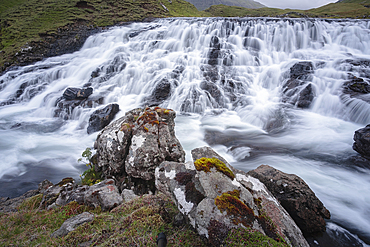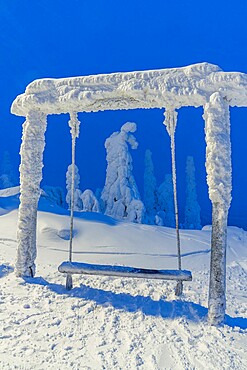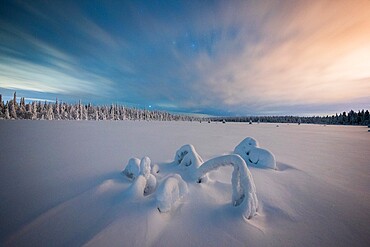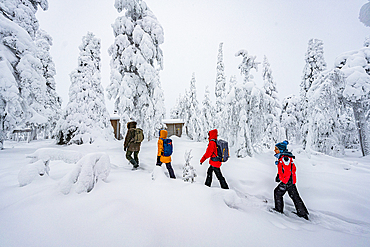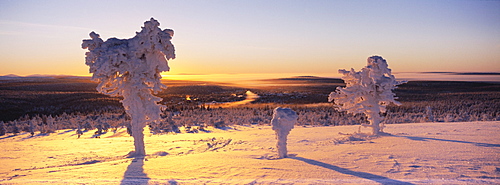Results
13 results found
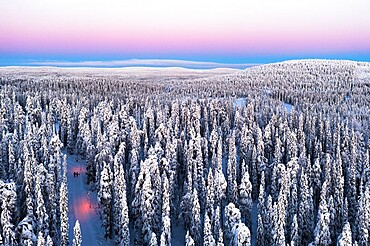
Aerial view of two hikers walking in the snowcapped forest at dawn, Iso-Syote, Lapland, Finland, Europe
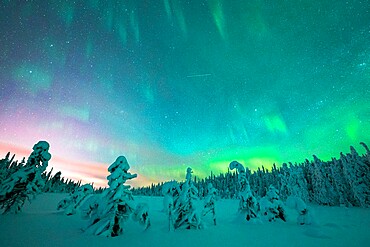
Frozen trees in the snow under the multi colored sky during the Northern Lights (Aurora Borealis) in winter, Iso Syote, Lapland, Finland, Europe
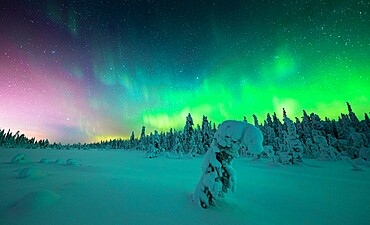
Frozen spruce tree covered with snow lit by Northern Lights (Aurora Borealis) in winter, Iso Syote, Lapland, Finland, Europe

Frozen trees under the starry sky during the Northern Lights (Aurora Borealis) in winter, Iso Syote, Lapland, Finland, Europe

Frozen spruce trees covered with snow lit by Northern Lights (Aurora Borealis) in winter, Iso Syote, Lapland, Finland, Europe

Isolated frozen trees in the snow under the Northern Lights (Aurora Borealis) in winter, Iso Syote, Lapland, Finland, Europe

Green lights of Northern Lights (Aurora Borealis) over frozen trees covered with snow, Iso Syote, Lapland, Finland, Europe

Aerial view of happy couple enjoying the winter holidays in a frozen hut in the snowy forest, Iso Syote, Northern Ostrobothnia, Lapland, Finland
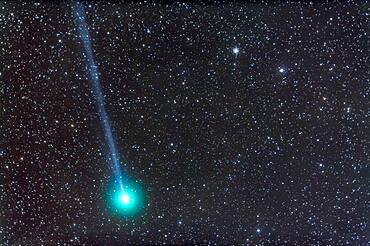
Comet Lovejoy (C/2104 Q2) on the night of Dec. 27/28, 2014, as it was approaching the globular cluster M79 at upper right, in Lepus. This is a stack of 5 x 3 minute exposures at ISO 2500 with the Canon 5D MkII and TMB 92mm refractor at f/4.4. Taken from near Silver City, New Mexico.
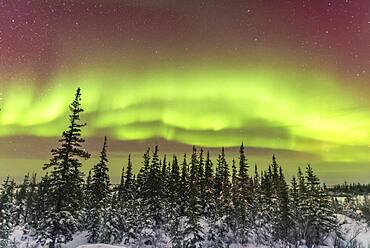
An aurora over the snowy boreal forest trees at the Chruchill Northern Studies Centre, Churchill, Manitoba, March 3, 2016. The display started the night quite impressively but then faded and subsided. This is a 10-second exposure a f/2 and ISO 3200 with the Nikon D750 and Sigma 20mm Art lens.
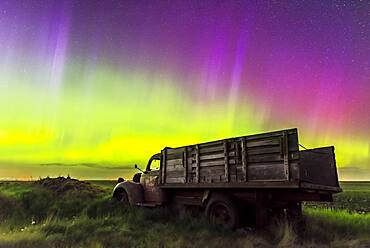
An aurora display on the night of June 7/8, 2015 from southern Alberta, with an old rustic farm truck as the foreground. This is a frame from a 450-frame time-lapse with the Nikon D750 at ISO 1600 and the Sigma 24mm lens at f/2.8, for 8 seconds each. The foreground is from a stack of 8 images adjacent in time to the sky image stacked in Mean mode for smoothing of noise.
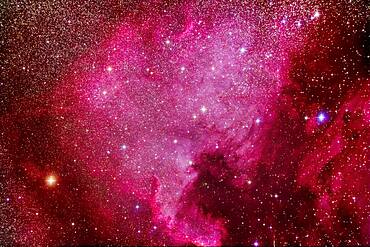
NGC 7000, the North America Nebula, with the Pelican Nebula, IC 5067, at right, in Cygnus, taken from home November 21, 2016 as part of testing of the Explore Scientific FCD100 102mm apo refractor. This is a stack of 5 x 6-minute exposures at f/7 with the ES field flattener, and at ISO 1600 with the filter-modified Canon 5D MkII. Star diffraction spikes added with AstronomyTools actions.
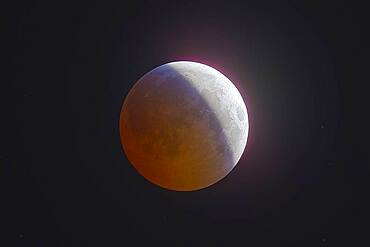
Total eclipse of the Moon, December 20/21, 2010, taken from home with 130mm AP apo refractor at f/6 and Canon 7D at ISO 400. An HDR composite of 9 images from 1/125 second to 2 seconds, composited in Photoshop CS5. Vibrancy increased to show bring out the colour variations across the shadow and at the edge of the shadow. Taken at about 12:21 am MST on Dec 21, about 20 minutes before totality began, during the partial phase.
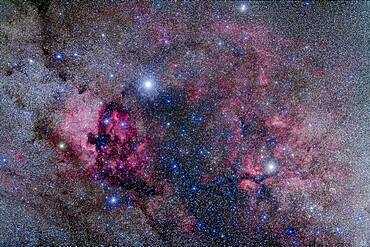
Nebulosity in the heart of Cygnus the Swan, including the North America Nebula and Pelican Nebula at left (NGC 7000 and IC 5070) and Gamma Cygni complex at right (IC 1318). The Crescent Nebula (NGC 6888) is at lower right. This is a stack of 5 x 4 minute exposures at f/2 with the 135mm lens and modified Canon 5D MkII at ISO 800, plus another three similar exposure images but taken thru the Kenko Softon filter for the star glows. Taken from home Sept 10, 2013.
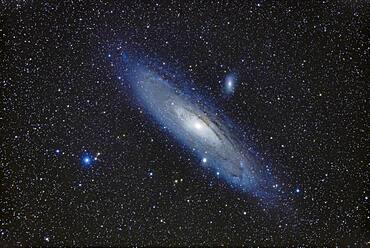
A demo image with the Orion 80mm CF Apo and Celestron AVX mount, with 3 x 8 minute and 3 x 6 minutes, at ISO 1600 with Canon 6D MkII plus shorter 3 x 2 minute and 3 x 1 minute exposures blended in with luminosity masks. Guided with the Orion Starshoot and Orion finderscope, using PHD2, with a lot of wild excursions in the guiding.

Comet Hartley 2 near the Pacman Nebula, NGC 281, in Cassiopeia. Stack of 4 x 6 minute exposures at ISO 1600 with Canon 5D MkII on A&M 105mm apo refractor at f/4.8 with Borg reducer/flattener. Bright star is Alpha Cas, Schedar. Autoguided with Celestron NexGuide autoguider. However, image of comet core is from only one exposure to minimize trailing from this fast-moving comet.

Astronomer Vance Petriew at the eyepiece of his 20-inch Dobsonian reflector telescope, at the 2012 Saskatchewan Summer Star Party in Cypress Hills, SK. This is a single 20 second exposure with the Canon 5DMkII at ISO 4000, and 24mm Canon L-series lens at f/2. A faint aurora adds the horizon colours. The photo was taken on the occasion of the second return of Comet Petriew 185/P since its discovery 11 years earlier in 2001 at this very same location.
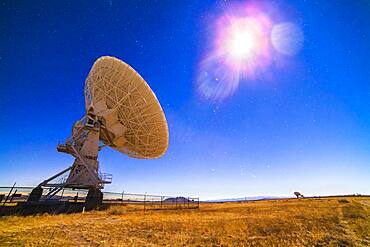
One of the 27 antennas of the Very Large Array (VLA) radio telescope complex in New Mexico (with others in the distance at lower right) illuminated by moonlight, on December 13, 2013, peak night for the Geminid meteor shower. A single exposure of 30 seconds with the Rokinon 14mm lens at f/2.8 and Canon 5D MkII at ISO 800. Orion is rising a lower centre. The Moon is the bright object at upper right. The Pleiades and Hyades are above centre.
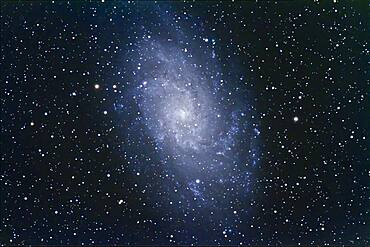
M33, the Triangulum Spiral, a dwarf spiral in the Local Group. This is a 6-image stack of 12-minute exposures with the Canon 7D at ISO 800 on the 130mm Astro-Physics apo refractor at f/6 on AP 600E mount and SBIG SG4 autoguider. Poor seeing bloated star images somewhat.
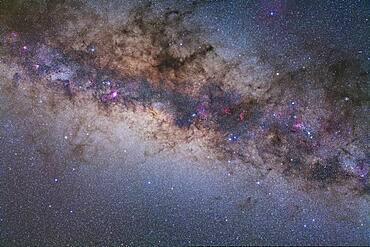
Sagittarius and Scorpius in diagonal framing, with Milky Way from Ara to Serpens. Taken with 50mm Sigma lens at f/4 and Canon 5D MkII at ISO 800 for stack of just 2 frames each at 6 minutes. Cloud prevented more exposures. Taken from Atacama Lodge, San Pedro de Atacama, Chile.
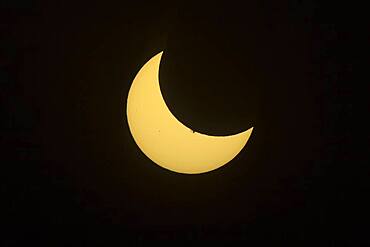
The partial eclipse of the Sun, October 23, 2014, as seen from Jasper, Alberta, shot under clear skies through a mylar filter, on the front of a 66mm f/6 apo refractor using the Canon 60Da for 1/8000 (!) sec exposure at ISO 100. The colours are natural, with the mylar filter providing a neutral 'white light' image. The big sunspot on the Sun that day is just disappearing behind the Moon's limb. The mylar filter gave a white Sun, its natural colour, but I have tinted the Sun's disk yellow for a more pleasing view that is not just white Sun/black sky.
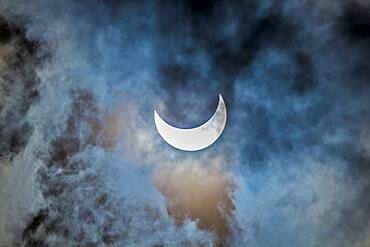
The partial eclipse of the Sun, October 23, 2014, as seen from Jasper, Alberta, in this case shot through thin cloud but that makes for a more interesting photo than one in a clear sky. This is still shot through a mylar filter, on the front of a 66mm f/6 apo refractor using the Canon 60Da for 1/25 sec exposure at ISO 100. The colours are natural, with the mylar filter providing a neutral 'white light' image. With the Sun dimmed a lot by cloud, the longer exposure allowed picking up light and colours in the surrounding clouds.
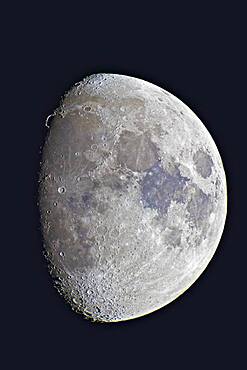
9-day-old gibbous Moon, taken April 23, 2010, with Astro-Physics 130mm apo refractor, plus 2x Barlow for f/12 and 1600mm focal length. Canon 7D camera at ISO 100. Seeing poor -- this was the sharpest of the lot.

Gum Nebula area of Vela and Puppis. Taken from Atacama Lodge, Chile, March 19, 2010, with modified Canon 5D MkII and Sigma 50mm lens at f/4, for stack of 10 x 6 minute exposures (Mean combined) at ISO 800 plus 2 x 6 minutes with Kenko Softon filter. High contrast boost and Selective Colour adjustments to bring out nebulocity while retaining neutral sky.
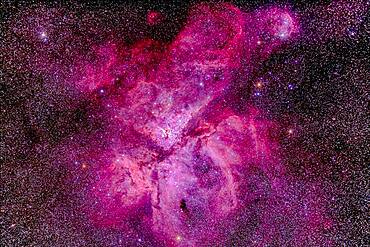
The Carina Nebula (aka Eta Carinae) in the southern sky, shot December 11, 2012 from Timor Cottage, Coonabarabran, NSW, Australia. This is a stack of 5 x 12 minute exposures at ISO 400 with the Canon 5D MkII (filter modified) and Astro-Physics 105mm Traveler apo refractor and 6x7 field flattener.
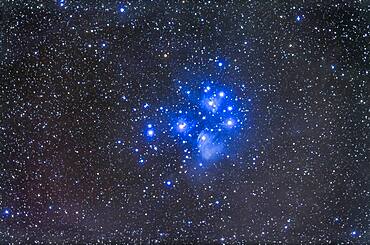
The Pleiades star cluster, aka Seven Sisters, or M45, in Taurus. A deep exposure showing the reflection nebulosity which fills the area. This is a stack of 5 x 14 minute exposures with the TMB 92mm apo refractor and Borg 0.85x flattener/reducer at f/4.8 and Canon 5D MkII at ISO 800. Taken from home Oct 9/10, 2013.
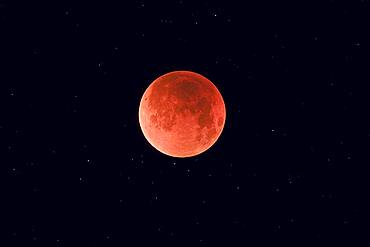
Taken with 90mm Stowaway AP Refractor, with Borg .85x compressor/flattener for f/5.6. With Canon 20Da camera at ISO 400 for 13 second exposure. on Skywatcher HEQ5 mount tracking at Lunar rate. Exposure kept long to bring out star background. original = 1

A telescopic closeup of Comet Lovejoy (C/2014 Q2) on January 19, 2015. I shot this from near Silver City, New Mexico, using a TMB 92mm apo refractor at f/4.4 and using a Canon 6D at ISO 1600 for a stack of 4 x 5 minute exposures. The ion tail is primarily from a single exposure to minimize blurring from the comet's motion relative to the stars. The rest of the image is from the stacked combination to minimize noise.

A stack of 25 x 2-minute exposures with Canon 200mm f/2.8 lens at f/4 and at ISO 1600 with Canon 6D.

Total eclipse of the Moon, December 20/21, 2010, taken from home with 130mm AP apo refractor at f/6 and Canon 7D at ISO 400 for 4 seconds, single exposure, shortly after totality began.

Containerterminal Bonn, stacked 40 feet ISO freight container in crane runway, gantry crane at back, North Rhine-Westphalia, Germany, Europe
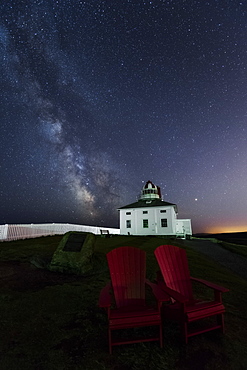
The original lighthouse at Cape Spear in Newfoundland sits dark, with the new lighthouse nearby. The original lighthouse started operation in 1836, and in 1955 a new concrete light tower was built. The original lighthouse has been restored to the period of 1839. This was tricky to shoot because the green light of the active lighthouse would flash every 7 seconds and wash out the scene in intense green. I didn't like the harsh shadows from the light, myself and my tripod being one of them, so I took a bunch of 6 second exposures and used stacking to get pinpoint stars and low noise in the sky and foreground. Nikon D5, Nikon 14-24mm f/2.8 lens @ 14mm and f/2.8. Six shots with the ISO between 12,800 and 25,600, as I was playing around with the camera to get a feel for its performance, stacked in Starry Landscape Stacker for Mac.
